
Orchids are plants that belong to the family Orchidaceae, a diverse and widespread group of flowering plants with blooms that are often colourful and fragrant. Orchids are cosmopolitan plants that are found in almost every habitat on Earth except glaciers. The world's richest diversity of orchid genera and species is found in the tropics.
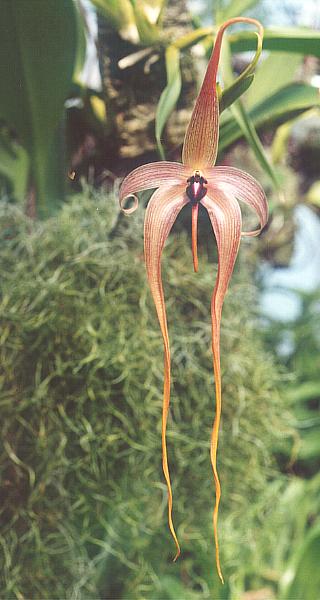
Bulbophyllum is a genus of mostly epiphytic and lithophytic orchids in the family Orchidaceae. It is the largest genus in the orchid family and one of the largest genera of flowering plants with more than 2,000 species, exceeded in number only by Astragalus. These orchids are found in diverse habitats throughout most of the warmer parts of the world including Africa, southern Asia, Latin America, the West Indies, and various islands in the Indian and Pacific Oceans. Orchids in this genus have thread-like or fibrous roots that creep over the surface of trees or rocks or hang from branches. The stem is divided into a rhizome and a pseudobulb, a feature that distinguished this genus from Dendrobium. There is usually only a single leaf at the top of the pseudobulb and from one to many flowers are arranged along an unbranched flowering stem that arises from the base of the pseudobulb. Several attempts have been made to separate Bulbophyllum into smaller genera, but most have not been accepted by the World Checklist of Selected Plant Families.
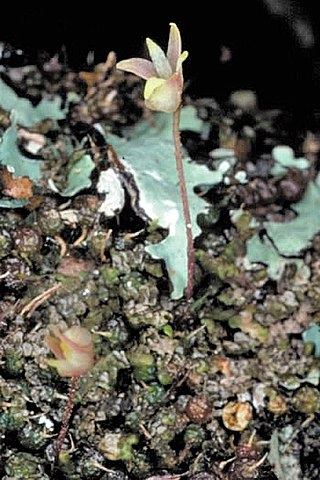
Bulbophyllum globuliforme, commonly known as the green bead orchid, miniature moss-orchid or hoop pine orchid, is a species of epiphytic orchid with tiny spherical pseudobulbs, scale-like leaves and small cream-coloured flowers with a yellow labellum. It grows on the scaly bark of hoop pine, mostly on the McPherson Range on the New South Wales/Queensland border in eastern Australia. Because of its small size it is often dismissed as moss.

Johannes Jacobus Smith was a Dutch botanist who, between years 1905 to 1924, crossed the islands of the Dutch East Indies, collecting specimens of plants and describing and cataloguing the flora of these islands. The standard botanical author abbreviation J.J.Sm. is applied to plants described by J.J. Smith.

Bulbophyllum fletcherianum, the tongue orchid, Fletcher's bulbophyllum or Spies' bulbophyllum, is a rare orchid native to southern New Guinea. It prefers sunny rock outcrops or mossy tree branches, but besides being lithophytic or epiphytic, it can also be pseudo-terrestrial. The tongue orchid requires high humidity and moist roots.

Phenanthrenoids are chemical compounds formed with a phenanthrene backbone. These compounds occur naturally in plants, although they can also be synthesized.
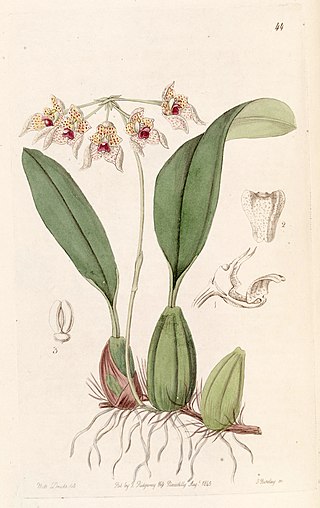
Bulbophyllum umbellatum is a species of orchid. It is native to tropical parts of South Asia, from the west central Himalayas to Taiwan and Indo-China.
Bulbophyllum abbreviatum is a species of orchid in the genus Bulbophyllum discovered in Madagascar and originally described by German botanist Rudolf Schlechter, from material collected by French botanist H. Perrier de la Bâthie in February 1912, which is now kept in the Muséum National d'Histoire Naturelle in Paris.

Bulbophyllum apodum is a species of orchid in the genus Bulbophyllum. It bears a 12–14 cm inflorescence with around 40 small fragrant white flowers on it. It is native to Sikkim, Borneo, China, Malaysia, Thailand, the Philippines, Vanuatu, and Vietnam.
Bulbophyllum minutissimum, commonly known as the red bead orchid or grain-of-wheat orchid, is a species of epiphytic or lithophytic orchid with small, flattened, reddish or green pseudobulbs, scale-like leaves and small whitish to reddish flowers with broad dar red stripes. It grows on trees and rocks, mostly in swamps and near streams in eastern Australia.

Bulbophyllum ovalifolium is a species of orchid in the genus Bulbophyllum.
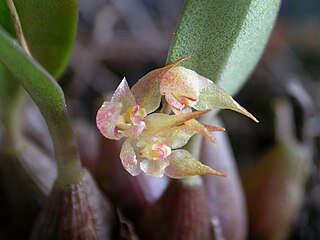
Bulbophyllum scabratum or Rough Bulb-Leaf Orchid is a species of orchid in the genus Bulbophyllum in section Eublepharon.
Bulbophyllum unguiculatum is a species of orchid in the genus Bulbophyllum. It is commonly known as the clawed bulbophyllum. It is found in Sumatra, Java, Borneo and Sulawesi in lower montane forests.
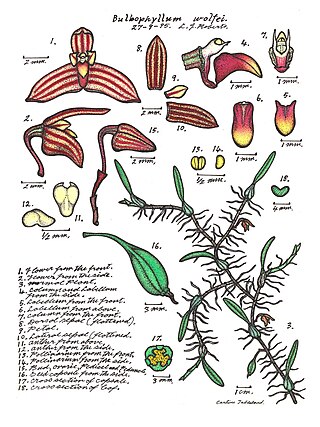
Bulbophyllum wolfei, commonly known as the fleshy snake orchid, is a species of epiphytic or lithophytic orchid with thin, creeping rhizomes, and flattened pseudobulbs each with a single thick, fleshy, dark green leaf and a single cream-coloured flower with dark red stripes. It mostly grows on rainforest trees in tropical North Queensland.
Bulbophyllum nocturnum is a species of epiphytic orchid that grows in New Britain. It was described in 2011, and is the first species of orchid known to consistently flower during the night, and close its flowers during the day.

Dendrobieae is a tribe in the subfamily Epidendroideae, in the family Orchidaceae. The Dendrobieae are mostly tropical, epiphytic orchids which contain pseudobulbs.
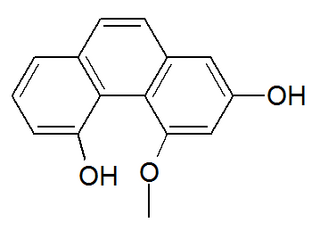
Plicatol B is one of the three phenanthrenes that can be isolated from the stems of the orchid Flickingeria fimbriata. It can also be isolated from Dendrobium densiflorum, D. loddigesii, D. moschatum, D. rotundatum and Bulbophyllum kwangtungense

Gymnopusin is a phenanthrenediol produced by the orchid Bulbophyllum gymnopus. It is also found in Bulbophyllum reptans and Maxillaria densa.
Jaap J. Vermeulen is a Dutch botanist, specializing in the Orchidaceae genus Bulbophyllum.
An attractant is any chemical that attracts an organism, e.g. i) synthetic lures; ii) aggregation and sex pheromones ; and iii) synomone












